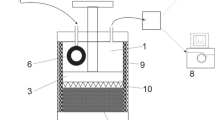Abstract
Possible scenarios of ignition and explosion development in coal mines are discussed. A principal possibility of complete quenching of detonation and combustion with the use of a sheet consisting of inert particles is experimentally demonstrated. As the detonation quenching process is rather complicated, it is recommended to focus the attention at the initial stage of ignition of the methane–air mixture, when it is possible to ensure effective quenching of the ignition site by using methods of advanced automatic monitoring and control with clear satisfaction of space and time requirements.
Similar content being viewed by others
References
Fire and Explosion Hazards of Substances and Materials and Means of their Quenching: Reference Book, Ed. by A. N. Baratov, A. Ya. Korolchenko, G. N. Kravchuk, et al. (Khimiya, Moscow, 1990) [in Russian].
B. Lewis and G. von Elbe, Combustion, Flame, and Explosions of Gases (New York, 1961).
K. K. Andreev and A. F. Belyaev, Theory of Explosives (Gostekhizdat, Moscow, 1960) [in Russian].
Chemical Encyclopedia, Ed. by I. L. Knunyants (Sov. Entsiklopediya, Moscow, 1988) [in Russian].
Hazardous Chemical Substances. Hydrocarbons. Halogenated Hydrocarbons: Reference Book, Ed. by V. A. Filov (Khimiya, Leningrad, 1990) [in Russian].
M. Hertzberg, “The Flammability Limits of Gases, Vapors and Dusts: Theory and Experiment,” in Fuel–Air Explosions, Ed. by Lee and Guirao (Univ. of Waterloo Press, 1982), pp. 3–48.
M. Hertzberg, K. L. Cashdollar, and I. A. Zlochower, “Flammability Limit Measurements for Dusts and Gases: Ignition Energy Requirements and Pressure Dependences,” in 21th Symp. (Int.) on Combustion, 1986, pp. 303–313.
H. J. Michels, G. Munday, and A. R. Ubbelohde, “Detonation Limits in Mixtures of Oxygen and Homologous Hydrocarbons,” Proc. Roy. Soc. A: 1539, Math. Phys. Sci. 319 (10), 461–477 (1970).
S. M. Kogarko, “Detonation of Methane–Air Mixtures and Detonation Limits of Hydrocarbon–Air Mixtures in a Large-Diameter Tube,” Zh. Tekh. Fiz. 38 (9), 2072–2083 (1958).
M. A. Nettleton, Gaseous Detonations, Their Nature, Effects and Control (Chapman and Hall, 1987).
Physics of Explosion, Ed. by L. P. Orlenko (Fizmatlit, Moscow, 2002) [in Russian].
A. Yu. Grachev, A. V. Novikov, K. V. Panevnikov, and D. B. Terekhov, “Multifunctional Safety System in a Coal Mine—Positioning and Staff Alerting,” Vestn. Nauch. Tsentra Bezopas. Rabot Ugol. Prom., No. 2, 121–129 (2016).
A. A. Vasil’ev, A. V. Pinaev, A. V. Trotsyuk, et al., “Complete Suppression of Combustion and Detonation Waves by a Dust Sheet,” Vestn. Nauch. Tsentra Bezopas. Rabot Ugol. Prom., No. 4, 12–21 (2015).
A. V. Pinaev, A. A. Vasil’ev, and P. A. Pinaev, “Suppression of Gas Detonation by a Dust Cloud at Reduced Mixture Pressures,” Shock Waves 25, 267–275 (2015); DOI 10.1007/s00193-014-0543-2.
A. V. Fedorov, P. A. Fomin, V. M. Fomin, et al., Physicomathematical Modeling of Detonation Suppression by Clouds Consisting of Fine Particles (ITPM SO RAN–NGASU, Novosibirsk, 2011) [in Russian].
A. V. Trotsyuk, P. A. Fomin, and A. A. Vasil’ev, “Numerical Study of Cellular Detonation Structures of Methane Mixtures,” J. Loss Prev. Process Ind. 36, 394–403 (2015); DOI: 10.1016/j.jlp.2015.03.012.
A. V. Trotsyuk, A. A. Vasil’ev, and A. V. Pinaev, “2D Numerical Simulation of the Dynamics of Detonation Wave Propagation in a Dusty Methane–Air Mixture,” Vestn. Nauch. Tsentra Bezopas. Rabot Ugol. Prom., No. 2, 82–90 (2016).
Author information
Authors and Affiliations
Corresponding author
Additional information
Original Russian Text © A.A. Vasil’ev, A.V. Pinaev, A.A. Trubitsyn, A.Yu. Grachev, A.V. Trotsyuk, P.A. Fomin, A.V. Trilis.
Rights and permissions
About this article
Cite this article
Vasil’ev, A.A., Pinaev, A.V., Trubitsyn, A.A. et al. What is burning in coal mines: Methane or coal dust?. Combust Explos Shock Waves 53, 8–14 (2017). https://doi.org/10.1134/S0010508217010026
Received:
Published:
Issue Date:
DOI: https://doi.org/10.1134/S0010508217010026




